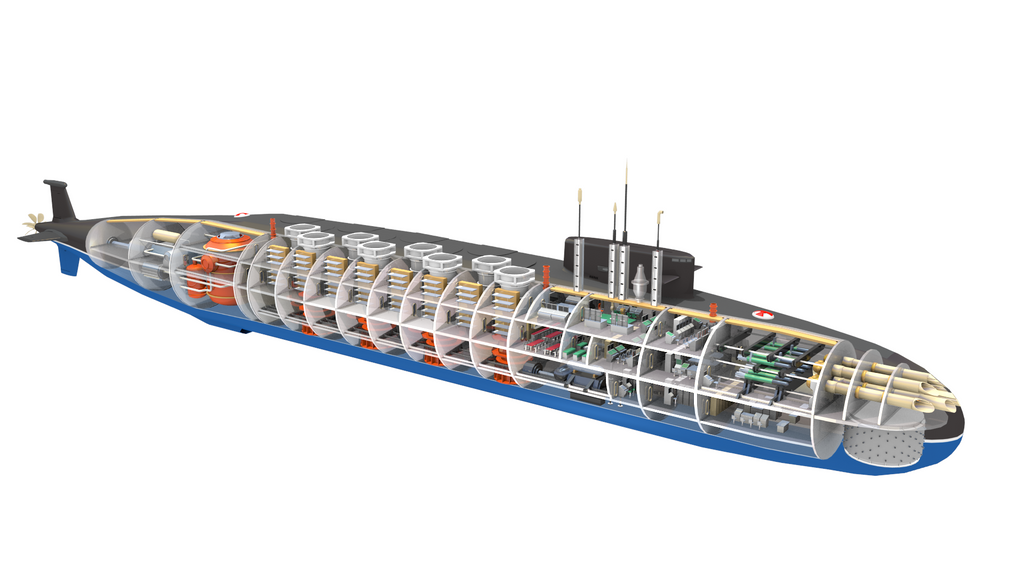India joins an elite club of five to have nuclear-powered submarine; pressurised water reactor will generate about 80 MWt.
The reactor on board India's nuclear-powered submarine, INS Arihant, reached its first criticality at 1.20 a.m. on Saturday, capping 25 years of indigenous efforts in this advanced, technologically challenging area. The main challenge lay in making the reactor compact enough to fit into a submarine, apart from ensuring its stability when the submarine accelerated the depths of the sea. Arihant is about 111 metres long, 11 metres broad and about 15 metres tall.
Arihant's reactor reached its criticality when the boat was "already in the sea". It is a pressurised water reactor (PWR) that will propel the nuclear-powered submarine. The reactor uses enriched uranium as fuel, and light water as both coolant and moderator. It will generate about 80 MWt. The submarine will be fitted with K-15 underwater fired missiles, which can take on targets 700 kms away. The K-15 missiles, which will carry nuclear warheads, are already under production.
India is building three more nuclear-powered submarines at Visakhapatnam as part of its programme to shore up its strategic programme and second strike capability. India is now a member of the exclusive club of five countries—U.S., Russia, the U.K., France and China— that already possess nuclear-powered submarines.
Arihant is a joint effort of the Department of Atomic Energy (DAE), the Defence Research and Development Organisation (DRDO) and the Navy. The Bhabha Atomic Research Centre (BARC), Trombay, which is the DAE's nerve-centre, played a pivotal role in designing and developing the PWR that powers Arihant. An identical PWR of the same capacity has already been operating on the shore of Kalpakkam, Tamil Nadu, from September 2006. The enriched uranium for both the reactors comes from the DAE's Rare Materials Plant (RMP), near Mysore.
Ariant's reactor and its twin at Kalpakkam are forerunners to the DAE building massive indigenous 900 MWe commercial PWRs in the country, which are already in the advanced stage of design.
R.K. Sinha, Chairman, Atomic Energy Commission (AEC), was upbeat about Arihant's nuclear-powered reactor going into operation. Mr. Sinha told The Hindu: "It is really a demonstration of very advanced technological capability in the challenging areas of nuclear reactor design, manufacture and commissioning. I am proud that this big effort has resulted in the reactor reaching first criticality. It is a moment of jubilation for the entire nuclear energy sector in the country, which has worked hard to make a reactor of this type."
The reactor on board was different from the reactors in the nuclear power stations in terms of compactness, safety parameters and the conditions at sea which it would encounter, Mr. Sinha said.
S. Basu, Director, BARC, who was one of the architects in building the Arihant's reactor, described the reactor reaching its first criticality as "a big achievement in terms of our defence preparedness and a follow-up to the PWR plant that is already operating at Kalpakkam". In building the PWR that propels Arihant, he said, "the Kalpakkam experience has been made use of here".
Mr. Basu added: "Everything went smoothly and as prescribed and predicted. A thorough preparation was done for the event to be conducted in a phased and disciplined manner, following all the safety stipulations." The BARC Safety Council gave the thumbs-up for the criticality.
Asked when Arihant's sea trials would be done, Mr. Basu said, "The boat is already in the sea. From now on, all trials will be sea trials." He explained that with the boat's reactor reaching first criticality, physics experiments on the reactor would be done. Step by step, the power output from the reactor would be increased. The reactor's primary system had been proven now. Next, the propulsion system, that is, the secondary system would be proved. "Once the propulsion system is proven and made operational, we will go for sea trials," said Mr. Basu, who was the Project Director of the PWR at Kalpakkam.
Mr. Sinha who is also the DAE Secretary, asserted that "the Indian industry has come of age in the manufacture of the PWR vessel, which has been used in Arihant's reactor". There were many other important systems and components which had gone into the reactor, which were completely indigenous and manufactured in India, he said.
It was on July 26, 2009 that Prime Minister Manmohan Singh's wife Gursharan Kaur broke a coconut to name India's first nuclear-powered submarine "Arihant", meaning destroyer of enemies, and launch it at the Naval Dockyard at Visakhapatnam. On that day, the Prime Minister specifically thanked "our Russian friends for their consistent and invaluable cooperation, which symbolises the close strategic partnership that we enjoy with Russia."
The project, originally called the Advanced Technology Vessel (ATV) programme, had its genesis in 1984-85 but active work on it began in the late 1990s.
Keywords: INS Arihant, nuclear reactor, activation, nuclear-tipped missiles









